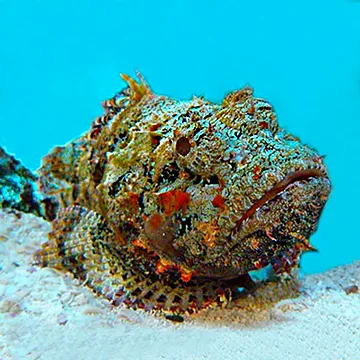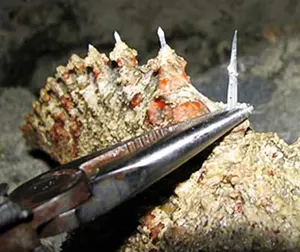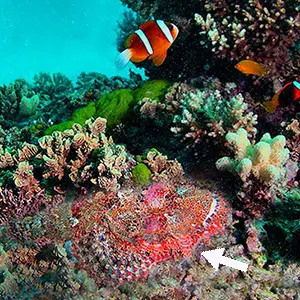What is a Stonefish?

Contents
The stonefish is the world's deadliest fish, earning its title as the most venomous fish on the planet. Known for its masterful camouflage, this ambush predator blends seamlessly with the ocean floor by mimicking rocks and coral and waits patiently for its prey. The powerful venomous spines on its back are for its defence and deliver an excruciating sting capable of causing intense pain and even death. Male and female stonefish are similar in appearance. However, the female is larger and broader around the abdomen than the male and can weigh 50% more.
How Dangerous are Stonefish?

Photo: Stonefish dorsal fin spines
The stonefish has 13 razor-sharp spines on its back loaded with potent neurotoxins that cause excruciating pain, paralysis, and even death. While stonefish rarely attack humans, their sting can be fatal without immediate medical intervention.
Do Stonefish Attack Humans?
Stonefish are not aggressive and do not attack humans. Most injuries occur when people accidentally step on or disturb a stonefish while wading in shallow waters. As the stonefish is well camouflaged, these accidents are often unavoidable. Fortunately, there have been no recorded deaths from stonefish stings in Australia.
Stonefish Sting Treatment: What to Do if Stung

Photo: Human foot after stonefish sting
If stung by a stonefish, immediate action is required:
1. Wash the wound with saltwater (not freshwater) to remove any venom.
2. Apply heat to the wound for 30-90 minutes. This helps inactivating the venom.
3. Seek medical help immediately for antivenom treatment if available.
Stonefish antivenom is one of the most frequently used treatments in Australia.
Where Do Stonefish Live?

Photo: Stonefish blending into its environment
The stonefish thrive in the shallow, tropical waters of the Pacific and Indian Oceans, especially around the Great Barrier Reef in Australia. Their preference for camouflage makes them difficult to spot in coral reefs and rocky seabed in which they lurk. Where there isn't sufficient environmental cover to disguise itself, the stonefish will use its powerful pectoral fins to dig itself into the seabed and pretend to be something most appropriate to its surroundings, typically an algae-covered rock—hence its name—Stonefish. Remarkably, stonefish can survive for up to 24 hours outside water, adapting to temporary environmental changes, such as low tides.
What Do Stonefish Eat?
Stonefish Catching Prey Video

Watch Video
Stonefish are ambush predators, eating mainly small fish, crustaceans, and other invertebrates. They are also cannibalistic, sometimes eating other stonefish.
They are ambush hunters, lying in wait until prey comes within striking distance. Their hunting technique is called ‘gape and suck’ where they open their huge mouths in a vacuum-like motion and suck prey into their gaping mouths in less than 1/100th of a second. (See video)
Can You Eat a Stonefish?
Yes, stonefish are edible when prepared properly. The venom breaks down upon cooking, making it safe to eat. In some regions of Japan and China, stonefish is considered a delicacy.
Stonefish Reproduction
During mating season, female stonefish lay eggs in crevices and protected areas. The male fertilizes the eggs and guards them until they hatch. Once hatched, stonefish larvae drift with the currents before settling on the ocean floor to begin their sedentary adult life. Stonefish can live for 5-10 years and may grow up to 50 cm in length.
What Kills Stonefish?
The main predators of adult stonefish are sharks, stingrays, moray eels, snappers, groupers and sea snakes. Young stonefish are particularly vulnerable to predation by other fish and very few survive to adulthood.
Stonefish Conservation Status
The worldwide stonefish population is not known. It is found throughout its various habitats. There is no evidence to suggest that it is threatened in any way. The stonefish is not endangered.
Stonefish vs Scorpionfish
Stonefish and Scorpionfish are often confused.
The stonefish is best at pretending to be a stone and is capable of less colour-matching compared to the scorpionfish. It is also the most venomous fish in the world. Only its dorsal fin is venomous.
The scorpionfish has more prominent eyes and can change its colour to better match its surroundings, including colourful corals. It has venomous spines on its back as well as on its fins. It isn't as venomous as the stonefish.
25 Stonefish Facts
- The stonefish is about 40-50cm in length with a warty grey-brown skin and patches of other colours.
- The stonefish is the most venomous fish in the world.
- It has 13 highly venomous spines hidden under its skin that break out when the fish is squeezed or pressed.
- Stonefish venom has cardiovascular and neuromuscular toxicity.
- Its sting is excruciatingly painful and can cause death.
- It doesn't attack humans.
- Instead, humans disturb it and get stung.
- The stonefish lives in shallow water off the Australian coastline.
- It is a stout 50cm long fish with excellent camouflage skills.
- Its skin is covered with nodules, bumps and other odd growths that appear like outgrowths of algae.
- Its favourite disguise is to pretend to be an algae-encrusted stone or clump of coral.
- The stonefish has a lifespan of 5-10 years and can survive out of water for up to 24 hours.
- Males and females are similar in appearance, But the female is 50% larger.
- The stonefish is a hide-and-wait predator and snaps up its prey when it passes close by.
- It eats other fish and bottom-dwelling invertebrates.
- It has a huge upward-opening mouth that can catch prey in 1/100th of a second.
- It sucks its prey into its huge mouth.
- The stonefish can survive out of water for up to 24 hours.
- Stonefish and Scorpionfish are often confused.
- The main predators of the stonefish are sharks, stingrays, and sea snakes.
- Stonefish antivenom is the second-most frequently used antivenom in Australia.
- No humans in Australia die from stonefish stings. There are many deaths in other countries.
- There are five species of stonefish worldwide.
- If prepared correctly, you can eat a stonefish.
- It is a delicacy in Japan and China.
Learn More About Animals of the Great Barrier Reef
Looking for more information on marine creatures? Check out our guides on other fascinating and dangerous animals from the Great Barrier Reef and beyond!